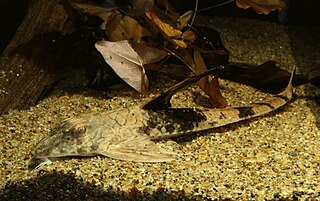
Loricariidae is the largest family of catfish, with 92 genera and just over 680 species. Loricariids originate from freshwater habitats of Costa Rica, Panama, and tropical and subtropical South America. These fish are noted for the bony plates covering their bodies and their suckermouths. Several genera are sold as "plecos", notably the suckermouth catfish, Hypostomus plecostomus, and are popular as aquarium fish.
Cordylancistrus is a genus of suckermouth armored catfish native to South America. It is much the same as Chaetostoma. The few differences are a wider head, longer cheek odontodes, and plates on the snout. Cordylancistrus can be found in rivers and streams high in the Andes, from Venezuela to Colombia.
Acestridium is a genus of freshwater fish in the family Loricariidae of order Siluriformes. The type species is Acestridium discus. The genus name is derived from Latinised Greek 'agkistron' meaning hook.

Hemiancistrus is a genus of suckermouth armored catfishes. These species are native to South America. The taxonomy of this genus is complex and unclear, and major work has to be done. Many of these fish are popular aquarium fish.
Lithogenes is a genus of South American catfish of the family Loricariidae. It is the only genus within the subfamily Lithogeneinae.

Farlowella is a genus of fish in the family Loricariidae native to South America. This genus is broadly distributed in Amazon, Orinoco, Paraná and coastal rivers of the Guyana Shield. It is absent from the Pacific slope of the Andes and from the coastal rivers of the Brazilian Shield. Many of these species are kept in aquariums. This genus has a unique body shape that resembles a thin stick of wood. The body is slender and elongate, often with a pronounced rostrum and a brownish color with two lateral dark stripes beginning at the tip of the rostrum, passing over the eyes and ending at the tail, which are periodically interrupted on the caudal peduncle.
Rhadinoloricaria is a genus of catfish endemic to South America. It was considered to be monotypic until the 2020 discovery of a second species.
Harttia is a genus of armored catfishes native to South America.
Pygidianops is a genus of pencil catfishes native to South America.
Typhlobelus is a genus of pencil catfishes native to South America.

Henonemus is a genus of pencil catfishes native to South America.
Pseudolithoxus is a genus of suckermouth armored catfishes with five described species from the basins of the Orinoco, Casiquiare and upper Rio Negro in Venezuela. Additionally, a possibly undescribed species is known from the Trombetas and Nhamundá rivers in Brazil.

Auchenoglanis is a genus of relatively large, up to 70 cm (2.3 ft) SL, claroteid catfishes native to various freshwater habitats in Africa.
Pseudolithoxus dumus is a species of armored catfish endemic to Venezuela where it occurs in the Orinoco, Negro and Casiquiare canal basins. This species grows to a length of 10.1 centimetres (4.0 in) SL.
Farlowella schreitmuelleri is a species of armored catfish endemic to Brazil where it is found in the lower Amazon basin. This species grows to a length of 18.1 centimetres (7.1 in) SL.
Acestridium dichromum is a species of armored catfish in the genus Acestridium. It is endemic to Venezuela, where it can be found in the upper Orinoco and Negro basins.
Acestridium gymnogaster is a species of armored suckermouth catfish in the genus Acestridium. They are endemic to the Madeira River in Brazil.
Acestridium scutatum is a species of armored suckermouth catfish in the genus Acestridium. It is native to the Madeira River basin in Brazil.
Acestridium triplax is a species of armored catfish in the genus Acestridium. It is native to the Amazon River in Brazil.
Rhadinoloricaria stewarti is a species of catfish in the family Loricariidae. It is native to South America, where it occurs in the drainage basin of the Cononaco River, a tributary of the Napo River, in Ecuador. The species was described in 2020 as part of a redescription of the genus Rhadinoloricaria conducted by Francisco Provenzano and Ramiro Barriga-Salazar. FishBase does not yet list this species.




